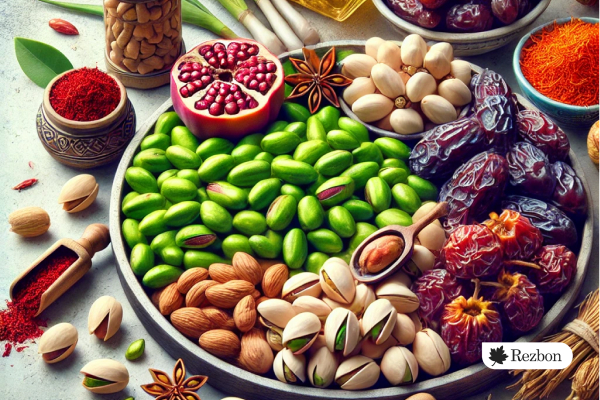Iran, with its diverse climate and fertile lands, is one of the world’s leading producers of a wide range of agricultural products. From saffron and pistachios to fruits and herbs, the country has an abundance of high-quality produce. Importing agricultural products from Iran can be a lucrative opportunity, but it requires understanding the specific processes, regulations, and market dynamics. This guide aims to provide a comprehensive overview of the steps, legal requirements, and best practices for successfully importing agricultural products from Iran.
1. Understanding Iran’s Agricultural Export Market
Iran’s agricultural sector is diverse, with key products including:
- Pistachios: Iran is one of the top exporters of pistachios globally.
- Saffron: Known as the “Red Gold,” Iran produces over 90% of the world’s saffron.
- Dates: Iranian dates, such as Mazafati and Piarom, are highly sought after worldwide.
- Fruits and Nuts: Iran produces a wide range of fruits (apples, pomegranates, grapes) and nuts (almonds, walnuts).
- Herbs and Spices: Iran is also known for its high-quality herbs and spices, including dried herbs, cumin, and coriander.
2. Regulatory Requirements
Before importing agricultural products from Iran, it’s essential to be aware of the legal and regulatory frameworks governing this process. These include both Iranian export regulations and the import requirements of the destination country.
2.1 Iranian Export Regulations
To export agricultural goods from Iran, businesses must adhere to the country’s export laws, which typically include:
- Licenses and Certifications: Exporters must have the necessary export licenses, and some products may require certification from the Iranian Chamber of Commerce.
- Quality Standards: Agricultural products must meet Iranian and international quality standards, especially for organic and processed goods.
- Sanitary and Phytosanitary Measures: Products must be free of pests and diseases, and certification from the Iranian Ministry of Agriculture may be required.
2.2 Destination Country Import Regulations
Import regulations vary by country, but generally include:
- Customs Duties and Tariffs: These vary depending on the country of import and the type of product. Some countries have trade agreements with Iran that may reduce tariffs.
- Sanitary and Phytosanitary Measures: Similar to Iran, the importing country may require specific certifications to ensure the product is safe for consumption and free of pests.
- Labeling Requirements: Products must adhere to the labeling regulations of the importing country, which may include information on ingredients, expiration dates, and nutritional content.
3. Logistics and Shipping
3.1 Choosing the Right Mode of Transportation
The choice of transportation largely depends on the type of product being imported and its perishability. Common options include:
- Air Freight: Suitable for perishable items like fresh fruits and herbs that need to be delivered quickly.
- Sea Freight: Most bulk agricultural products, such as nuts and dried fruits, are shipped via sea freight due to cost-effectiveness.
- Land Transport: If importing from Iran to neighboring countries, land transportation is a viable option.
3.2 Shipping Documentation
Key documents required for shipping agricultural products from Iran include:
- Bill of Lading: A document issued by the carrier that outlines the details of the shipment.
- Certificate of Origin: This proves that the product was produced in Iran and may be required for customs.
- Phytosanitary Certificate: This ensures that the product meets the necessary sanitary requirements.
- Commercial Invoice and Packing List: These detail the value and contents of the shipment for customs purposes.
4. Sourcing Agricultural Products in Iran
4.1 Finding Reliable Suppliers
To ensure the quality and reliability of the agricultural products you import from Iran, it’s essential to work with reputable suppliers. Tips for finding reliable suppliers include:
- Visiting Agricultural Exhibitions: Iran hosts several agricultural fairs and exhibitions where you can meet producers and exporters.
- Using Online Marketplaces: Platforms like Alibaba, TradeKey, or Iran’s Chamber of Commerce website can connect you with verified exporters.
- Third-Party Inspection Services: Before finalizing a deal, consider using a third-party inspection service to verify the quality and authenticity of the product.
4.2 Negotiating Contracts
When negotiating with Iranian suppliers, ensure that all terms are clearly stated in a written contract, including:
- Product Specifications: This includes quality, quantity, and packaging.
- Payment Terms: Decide whether payment will be made upfront, upon shipment, or after delivery.
- Incoterms: Agree on shipping terms, such as FOB (Free on Board) or CIF (Cost, Insurance, and Freight), which outline who is responsible for shipping and insurance costs.
5. Market Dynamics and Opportunities
5.1 High-Demand Products
Certain Iranian agricultural products have a high demand in international markets, including:
- Pistachios: Especially popular in Europe, the Middle East, and North America.
- Saffron: Sought after globally for culinary and medicinal uses.
- Dates: A staple in Middle Eastern markets and gaining popularity in Western countries.
- Organic Products: Increasing demand for organic fruits, vegetables, and herbs opens up new opportunities for Iranian exporters.
5.2 Challenges to Consider
Importing agricultural products from Iran may present some challenges, including:
- Sanctions and Trade Restrictions: Some countries may have trade sanctions in place against Iran, which could limit the import of certain goods.
- Currency Fluctuations: Iran’s currency, the rial, can be volatile, so it’s essential to consider currency exchange rates when negotiating prices.
- Quality Control: Ensure that the agricultural products meet the quality standards of your country by arranging pre-shipment inspections.
6. Conclusion
Importing agricultural products from Iran offers significant opportunities for businesses looking to capitalize on the country’s high-quality produce. However, it is crucial to navigate the complex regulatory environment, establish reliable supplier relationships, and manage logistics carefully. By following the steps outlined in this guide and conducting thorough research, businesses can successfully import agricultural products from Iran and tap into a market known for its rich agricultural heritage.


